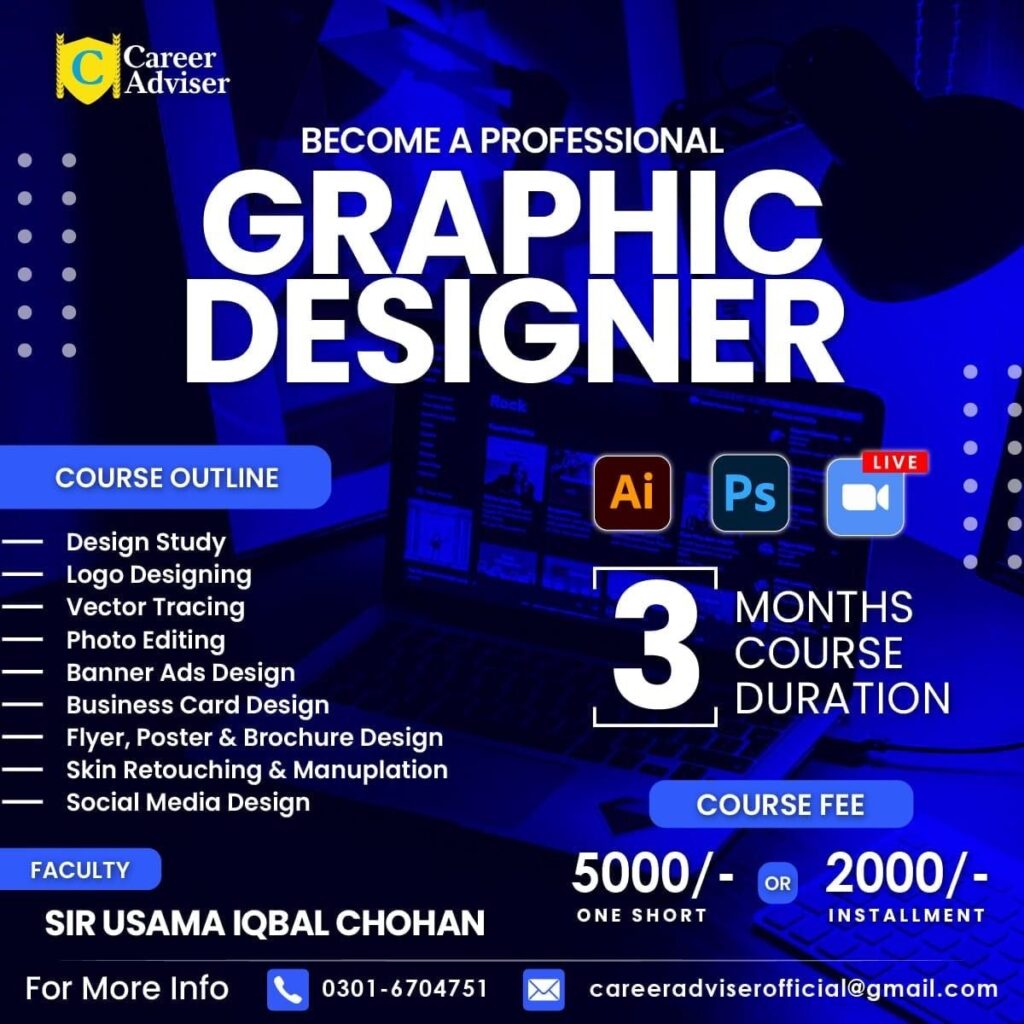My Journey from Doodler to Designer: Why a Graphic Design Course Was My Best Creative Leap
I used to spend hours just staring at cool designs online, feeling a mix of awe and a little bit of envy. "I wish I could do that," I’d often mumble to myself. But the idea of actually learning graphic design felt like trying to pilot a spaceship. It seemed complicated, expensive, and frankly, a bit intimidating. Did I need to be an amazing artist? Did I have to know all these fancy software programs already? The questions piled up, forming a wall between me and my creative dreams.
But that little voice inside me, the one that loved bright colors and interesting shapes, just wouldn’t quiet down. One day, I decided enough was enough. What was the worst that could happen? I’d try, maybe struggle, and then at least I’d know. That’s when I started looking into graphic design courses.
Taking the Plunge: Finding the Right Course for Me
The internet is a vast place, and searching for "graphic design course" brought up a dizzying array of options. Online, in-person, short workshops, long diplomas… it was a lot. I wasn’t ready to commit to a full university degree, but I also didn’t want just a quick tutorial that left me hanging. I needed something structured, beginner-friendly, and practical.
I looked for courses that:
- Were designed for beginners: No prior experience required was a huge plus.
- Covered the basics thoroughly: I wanted to understand why designs worked, not just how to copy them.
- Taught popular software: Photoshop, Illustrator, and maybe InDesign were on my list.
- Offered projects and feedback: I knew I’d learn best by doing.
- Had good reviews: Hearing from other students was important.
After a fair bit of research (and a few false starts), I found one that felt just right. It was an online graphic design course that promised to take me from zero to creating my own portfolio. It felt like a big step, a real investment in myself. My fingers trembled a little as I hit ‘enroll.’
The First Steps: Decoding the Language of Design
The first few modules of the course were like learning a new language. Suddenly, colors weren’t just colors; they had psychology and meaning. Typography wasn’t just about picking a "pretty" font; it was about readability, mood, and hierarchy. Layout wasn’t just putting things on a page; it was about flow, balance, and creating visual interest.
Our instructors (who were actual designers, which was awesome) broke everything down. We learned about:
- Color Theory: How different colors make people feel, how to combine them effectively, and what makes a palette harmonious. This was an "aha!" moment for me. I started seeing colors in ads and logos in a whole new light.
- Typography: The power of fonts! Serif, sans-serif, script – when to use what, how to pair them, and how size and spacing can completely change a message. I realized good typography is often invisible, but bad typography screams at you.
- Composition & Layout: This was about arranging elements on a page or screen. Think about how a magazine spread or a website homepage guides your eye. We learned about grids, whitespace (the empty spaces that are actually super important!), and how to create a focal point.
- Branding Basics: What makes a logo memorable? How does a brand communicate its identity? This part was fascinating, as it connected design directly to business and communication.
It wasn’t always smooth sailing. There were times I’d stare at a blank canvas, completely stumped. But the course structure, with its clear explanations and small exercises, kept me going. Each principle we learned felt like a new tool in my creative toolbox.
Taming the Beasts: My First Encounters with Design Software
Okay, let’s talk about the software. Before the course, Photoshop and Illustrator felt like these mythical, complex programs only wizards could use. My first encounter was a bit like trying to pilot a spaceship with a thousand buttons. I felt overwhelmed.
The graphic design course introduced us to these tools step by step:
- Adobe Photoshop: This is where we learned about image manipulation – cropping, retouching, adjusting colors, and creating cool effects. My first project was taking a simple photo and transforming it into something artistic. It was fiddly at first, but seeing the results was incredibly satisfying.
- Adobe Illustrator: This was for vector graphics – things like logos, illustrations, and icons that can be scaled to any size without losing quality. Learning to draw with the Pen tool felt like drawing with a very stubborn digital pencil, but once it clicked, it was magic. Creating my first clean, scalable logo was a proud moment.
- Adobe InDesign: For projects involving lots of text and images, like brochures, magazines, or e-books. This taught me about organizing information clearly and beautifully.
The instructors provided detailed video tutorials and practical exercises. We’d follow along, pause, rewind, and try again. They emphasized practice, practice, practice. And they were right. The more I used the software, the less scary it became, and the more intuitive it felt. It wasn’t about being a tech genius; it was about patience and repetition.
The Thrill of Creation: Projects and Portfolio Building
One of the most valuable aspects of the graphic design course was the project-based learning. It wasn’t just theory; it was applying everything we learned to real-world scenarios.
We worked on a variety of projects:
- Designing a hypothetical brand identity, including a logo, business card, and social media graphics.
- Creating a poster for a fictional event.
- Designing a website landing page layout.
- Developing an infographic to explain a complex topic visually.
These projects were challenging but incredibly rewarding. I got constructive feedback from instructors and sometimes even from fellow students, which was invaluable. It taught me that design isn’t about getting it perfect on the first try; it’s an iterative process of refining, revising, and improving.
And the best part? Each completed project became a piece for my portfolio. By the end of the course, I had a collection of diverse design work that showcased my new skills. This wasn’t just for potential employers; it was proof to myself that I could do this.
Beyond the Pixels: Community and Confidence
What truly surprised me about taking a graphic design course, especially an online one, was the sense of community. There was a dedicated forum where students could ask questions, share their work, and offer encouragement. Seeing others struggle with the same things, and then seeing their breakthroughs, made me feel less alone in my learning.
Our instructors weren’t just teachers; they were mentors. They shared their own experiences, offered career advice, and genuinely celebrated our successes. This human connection made the learning experience so much richer.
By the time I finished the course, I wasn’t just someone who knew how to use design software. I was someone who understood why certain designs worked, how to communicate a message visually, and how to approach a creative problem with confidence. My fear had turned into excitement, and my initial intimidation had transformed into a passion.
Is a Graphic Design Course Right for You?
If my story resonates with you – if you’re curious about design, want to unleash your creativity, or are even thinking about a career change – then yes, a graphic design course might just be your next best step.
Here’s why I think it’s so valuable, especially for beginners:
- Structured Learning: It cuts through the overwhelm of self-teaching. You get a clear path from basics to more advanced topics.
- Expert Guidance: Learn from experienced designers who can share best practices and give you personalized feedback.
- Hands-on Practice: You don’t just learn about design; you do design, building practical skills.
- Software Mastery: Get comfortable with industry-standard tools like Photoshop, Illustrator, and InDesign.
- Portfolio Building: You’ll graduate with a collection of work to showcase your talents.
- Confidence Boost: There’s nothing quite like the feeling of creating something beautiful and effective from scratch.
Looking back, that graphic design course wasn’t just a series of lessons; it was a doorway to a whole new way of seeing the world and expressing myself. It taught me that creativity isn’t an exclusive club for a select few. It’s a skill that can be learned, honed, and celebrated by anyone willing to take the leap.
So, if you’ve been on the fence, I encourage you to explore your options. You might just discover a passion and a talent you never knew you had.
Frequently Asked Questions (FAQs) About Graphic Design Courses
Q1: Do I need to be artistic to take a graphic design course?
A: Not at all! While an appreciation for aesthetics helps, graphic design is more about visual problem-solving and communication than traditional art skills. You don’t need to be able to draw perfectly. The course will teach you the principles and tools.
Q2: How long does a typical graphic design course take?
A: This varies widely. Short introductory courses might be a few weeks, while comprehensive online programs or diplomas can range from 3 months to a year or more, depending on the intensity and depth of the curriculum.
Q3: What software will I learn in a graphic design course?
A: Most reputable courses focus on the Adobe Creative Suite, primarily Adobe Photoshop (for image editing), Adobe Illustrator (for vector graphics like logos), and Adobe InDesign (for page layout). Some courses might also touch on Figma, Sketch, or other specialized tools.
Q4: Can I get a job after completing a graphic design course?
A: Yes, many people do! A good course will equip you with foundational skills and help you build a portfolio, which is crucial for getting hired. Entry-level positions like junior graphic designer, design assistant, or even starting as a freelancer are common paths. Continued learning and networking are also key.
Q5: Is an online graphic design course as effective as an in-person one?
A: Absolutely! Online courses offer flexibility and often provide access to a wider range of instructors and resources. Many even offer live sessions and peer interaction. The effectiveness largely depends on your self-discipline and the quality of the course content and support.
Q6: What’s the difference between graphic design and web design?
A: Graphic design is a broader field focused on visual communication, covering everything from logos and branding to print materials and digital graphics. Web design specifically focuses on the visual layout, user experience (UX), and user interface (UI) of websites and web applications. There’s often overlap, and many designers specialize in one or the other, or both.



